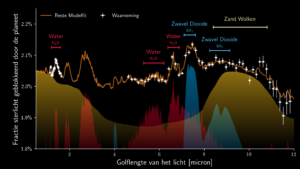Een team van Europese astronomen, met co-hoofdauteur Michiel Min (SRON), heeft een weersysteem op basis van silicaat gevonden op een wollige gasplaneet rond de ster WASP-107. Het is voor het eerst dat wetenschappers zandwolken en -regen vinden. Ze concluderen bovendien dat de temperatuur dieper in de atmosfeer snel stijgt. Publicatie in Nature.

Exoplaneet WASP-107b draait om een ster die iets koeler en lichter is dan onze Zon. De planeet is ongeveer even zwaar als Neptunus, maar een stuk groter, met bijna de omvang van Jupiter. Dat maakt haar dichtheid veel lager dan wat we gewend zijn in ons Zonnestelsel, waarmee ze de bijnaam suikerspinplaneet heeft verdiend. Die wolligheid stelt astronomen in staat om vijftig maal dieper in haar atmosfeer te kijken dan in die van Jupiter. Zo kregen ze zicht op de aanwezigheid van waterdamp, zwaveldioxide, silicaatwolken, en de afwezigheid van methaan.
De astronomen gebruiken de spectra van waterdamp en zwaveldioxide om ze te vergelijken met die in hun modellen voor planeten met en zonder wolken. De spectra vertonen weinig scherpe details, net zoals in de modellen met wolken. ‘Wolken hoog in de atmosfeer verbergen grotendeels de waterdamp en zwaveldioxide,’ zegt Rens Waters (Radboud Universiteit), een van de auteurs. ‘De aanwezigheid van wolken is al op andere planeten aangetoond, maar dit is de eerste keer dat we zien waar ze van gemaakt zijn. In dit geval is het antwoord: silicaat, dus eigenlijk zand.’ Co-auteur Nicolas Crouzet (Universiteit Leiden): ‘Dankzij het mede door NOVA in Nederland ontwikkelde MIRI instrument kunnen we de samenstelling van zandwolken voor het eerst heel nauwkeurig meten.’
Terwijl we op aarde water zien verdampen bij hoge temperaturen, zien weersystemen er anders uit op gasplaneten met temperaturen van rond de 1000 °C. Daar zijn het silicaatdeeltjes die verdampen als het warm wordt. Maar op WASP-107b is het ‘slechts’ 500 °C in de buitenste atmosfeerlaag. Bij het uitregenen van een wolk zou de zandregen dan pas diep in het binnenste weer verdampen—te diep om als wolk weer helemaal naar boven te drijven. Toch moeten de wolken steeds weer opnieuw ontstaan, anders zien we ze nu niet. ‘Het lijkt erop dat het al verrassend snel onder de bovenlaag heel heet wordt,’ zegt co-hoofdauteur Michiel Min (SRON). ‘Daar verdampt de zandregen om opnieuw wolken te vormen en naar boven te drijven. Eigenlijk net zoals het watersysteem op aarde.’
De afwezigheid van methaan is een tweede indicatie voor een snel stijgende temperatuur, zegt Min. ‘Bij lage temperaturen is het te verwachten dat methaan een belangrijke component van de atmosfeer is, vergelijkbaar met Jupiter waar methaan veel voorkomt. Een hoge interne temperatuur vernietigt methaan diep in de atmosfeer.’

Een transmissiespectrum van de ‘suikerspinplaneet’ WASP-107b, gemeten op 19-20 januari 2023 door de James Webb ruimtetelescoop. Op het moment dat de planeet voor haar moederster WASP-107 langs vliegt, laat de atmosfeer deze handtekening achter in het sterlicht. Hierin is de aanwezigheid te zien van waterdamp, zwaveldioxide en silicaat, en de afwezigheid van methaan.
Publicatie
‘SO2, silicate clouds, but no CH4 detected in a warm Neptune’, Achrene Dyrek, Michiel Min, Leen Decin, et al., Nature
James Webb discovers sand clouds on “cotton candy planet” WASP-107b
An international team of astronomers, co-led by Michiel Min (SRON), has discovered a silicate-based weather system on a fluffy gas planet around the star WASP-107. It is the first time that scientists find clouds and rain made of sand. They also conclude that the temperature deeper in the atmosphere is rising surprisingly rapid. Publication in Nature.

Exoplanet WASP-107b orbits a star that is slightly cooler and lighter than our Sun. The planet is about the same mass as Neptune, but much larger, almost the size of Jupiter. That makes its density much lower than what we are used to in our Solar System, hence the nickname cotton candy planet. This fluffiness allows astronomers to look fifty times deeper into its atmosphere compared to Jupiter. It enabled them to spot the presence of water vapor, sulfur dioxide, silicate clouds, and the absence of methane.
The astronomers use the spectra of water vapor and sulfur dioxide to compare them with those in their models for planets with and without clouds. The spectra show few sharp details, just like in the models with clouds. ‘Clouds high in the atmosphere largely block the water vapor and sulfur dioxide from view,’ says Rens Waters (Radboud University), one of the authors. ‘The presence of clouds has already been demonstrated on other planets, but this is the first time we see what they are made of. In this case the answer is: silicate, so basically sand.’ Co-author Nicolas Crouzet (Leiden University): ‘Thanks to the MIRI instrument developed in part by NOVA in The Netherlands, we can measure the composition of sand clouds very accurately for the first time.’
Whereas on earth water evaporates on a warm day, weather systems follow a different script on gas planets with temperatures around 1000 °C. In that case, silicate particles are the ones that evaporate when it gets warm. However on WASP-107b the outer atmospheric layer is ‘just’ 500 °C. So when a cloud rains out, the sand rain wouldn’t evaporate until it reaches deep into the interior—too deep to drift all the way back to the top as a cloud. Yet the clouds must be forming over and over again, otherwise we wouldn’t see them now. ‘It seems that it gets very hot surprisingly close beneath the top layer,’ says co-lead author Michiel Min (SRON). ‘There the sand rain evaporates to form clouds again and float upwards. Basically just like the water system on earth.’
The absence of methane is a second indication of rapidly rising temperatures, Min says. ‘With low temperatures it is expected that methane is an important component of the atmosphere, comparable to Jupiter where methane is common. A high internal temperature destroys methane deep in the atmosphere.’

A transmission spectrum of the ‘cotton candy planet’ WASP-107b, measured on January 19-20, 2023 by the James Webb Space Telescope. When the planet passes in front of its host star WASP-107, the atmosphere leaves this signature in the starlight. It shows the presence of water vapor, sulfur dioxide and silicate, and the absence of methane.
Publication
‘SO2, silicate clouds, but no CH4 detected in a warm Neptune’, Achrene Dyrek, Michiel Min, Leen Decin, et al., Nature


